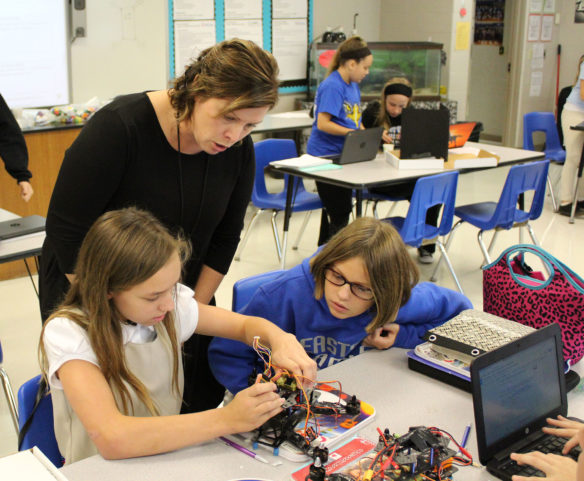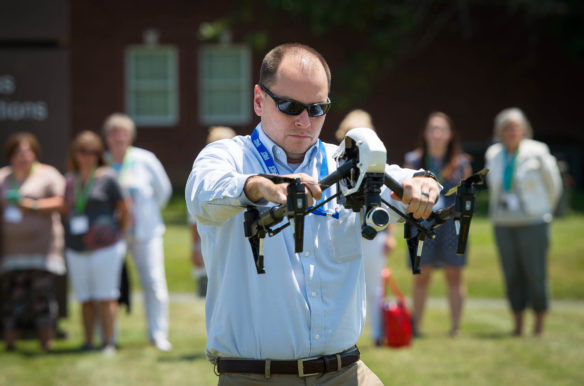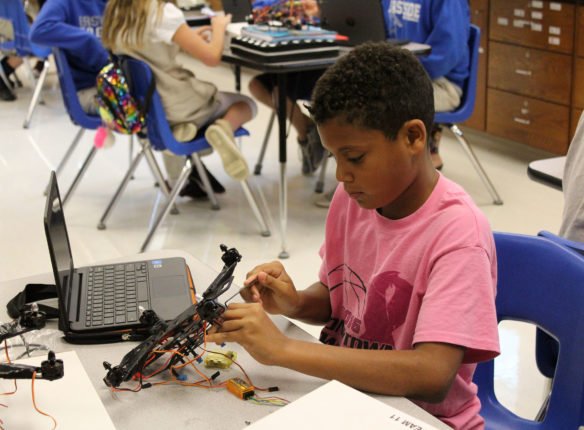
Anne Lopez, a STEM instructor at Eastside Middle School (Bullitt County), assists 7th-grade students Abby Davidson, left, and Sarah Fritz as they work during Lopez’s drone engineering class. Students research, design and build drones during the nine-week class, which is designed to teach the engineering design process.
Photo by Mike Marsee, Sept. 11, 2017
By Mike Marsee
mike.marsee@education.ky.gov
Anne Lopez has seen what drones can do for students.
She has seen her students’ eyes light up when a drone whirrs to life, and she has seen those students throw themselves into a project in which they design and build their own drones.
Drones are circling around an increasing number of Kentucky schools as teachers like Lopez, a STEM instructor at Eastside Middle School (Bullitt County), turn to them to engage their students.
“Kids love drones,” Lopez said. “You just say the word drones in the classroom and everybody lights up.”
In many cases, drones are being used to supplement any number of subject areas. Lopez is doing much more, however, as she uses the unmanned flying machines to drive home engineering concepts in a nine-week class.
“I know other districts that are doing some things with drones, but I don’t know any other district that’s doing what we’re doing, taking a whole nine weeks,” she said. “It’s not just a project within the course; it is the course.”
Lopez’s course provides one example of the ways teachers are using drones to give students a look at a future they might not have previously considered.
“There’s a lot of different things that teachers can do with them, from coding and programming to teaching social studies and English. There’s also math, science, biology, geometry, physics,” said Justin Allen, a producer/director at Kentucky Educational Television (KET) who led a workshop on the use of drones at KET’s Multimedia Day earlier this summer. “It’s using the drone to teach a concept, and it keeps people entertained.”

Justin Allen, a producer/director at Kentucky Educational Television, demonstrates how to calibrate a drone during a workshop as part of KET’s Multimedia Day for teachers. Allen said drones can be used by teachers in many different content areas.
Photo by Bobby Ellis, July 19, 2017
Allen said the first priority for teachers who used drones should be keeping their students and themselves safe. He said that’s why it’s important not to give students the freedom to fly a drone as soon as the box is opened.
“You’ve got a bunch of people that haven’t used them before, that don’t know how to use them safely, trying to fly them around the soccer field out back,” he said. “Training literally starts in the classroom. There are a number of different simulators that you can use to learn how to fly and different procedures that you can use to make sure you’re doing it the right way and the safe way.”
Lopez is in her third year of teaching drone engineering to 7th-grade students at Eastside Middle. The class, part of a cluster of engineering-related courses that also includes design and modeling for 6th-graders and automation and robotics for 8th-graders, uses drones to teach the engineering design process.
“We started with eight kits in one class, and now we have two classrooms with 16 kits each,” Lopez said. “When I created the program, I didn’t know how much students would like it or be invested in it, but this is the class kids can’t wait for. It’s not an easy course for them to do, but they really love it. I love that I’m sparking that interest in engineering for these kids.”
Students begin by researching the history and safety of drones, then study the engineering and design process. Teams of two students design their own drone, then assemble it using standard pieces from the kits, which were acquired by the school through grants. They test fly the drones, then enter a second design phase in which they choose a practical application for their machine.
“We take it past the initial process and extend it into real-world applications for them,” Lopez said.
She said some of the applications being developed by her current students include delivering items such as shoes and pet food from retailers to customers and delivering materials such as lab supplies between teachers and students.
“By the end of nine weeks, I think they understand they have to put in more work than just the building process,” she said. “They have to continue to learn through their failures. Students need that skill, where they come up with two or three ways to solve a problem and try them out.”
Lopez said she wanted to use her class in part to encourage girls to consider careers in engineering. She said several girls who took her earliest drone engineering classes are now in engineering classes at Bullitt East High School, where the program has grown from seven students to more than 200 in two years.
“As a female engineering teacher, that’s really encouraging to me to see the impact that I’m making on them,” she said.

Jordan Pound, a 7th-grade student at Eastside Middle School (Bullitt County), adds a piece to his drone during the drone engineering class. The class is part of a cluster of engineering courses the school offers for students in grades 6-8.
Photo by Mike Marsee, Sept. 11, 2017
Suzanne Weaver, who teaches engineering and architecture at Henry Clay High School (Fayette County) and who attended the KET workshop, said she would like to see a career pathway centered on drones in her district.
“I’d like to see how we can find ways that students can see this as a possibility for their future. Maybe this could be a venture for our career and tech centers,” Weaver said. “I would be very interested in being trained and going to the different high schools and teaching it.”
Drones have just become part of the engineering technology and industrial technology pathways at the Laurel County Schools Center for Innovation. A grant from local electric cooperative Jackson Energy has helped launch a drone engineering program this year.
The school’s engineering, industrial and media programs are collaborating in the design, production, testing and deployment of an original-design drone, with mathematics and English instructors assisting students during the research and design phases.
“As we move forward with our Engineering Technology and Industrial Technology program into the third year, I believe we are positioning our Laurel County Schools Center for Innovation students well for remarkable opportunities in aerospace engineering,” Center for Innovation Principal James Davis said.
The electric cooperative will benefit from the project because it will be able to use the drone to assess storm damage in rugged terrain.
Allen, who uses drones frequently in his work for KET and in outside work, said drones are being used in more and more fields.
“They’re being used in video production, in real estate. They’re being used in agriculture to see how the crops are doing. They’re being used in construction, in mining,” he said.
Schools looking to buy drones will find that prices vary greatly. Allen said what he considers “a good quality drone” sells for $1,000 to $1,500.
“It is a little bit of an investment, but you can get in as low as $500, or even a little bit cheaper than that for a smaller drone,” he said.
MORE INFO …
Paul Green paul.green@hazard.kyschools.us
Anne Lopez anne.lopez@bullitt.kyschools.us
Suzanne Weaver suzanne.weaver@fayette.kyschools.us
Justin Allen jallen@ket.org



Leave A Comment